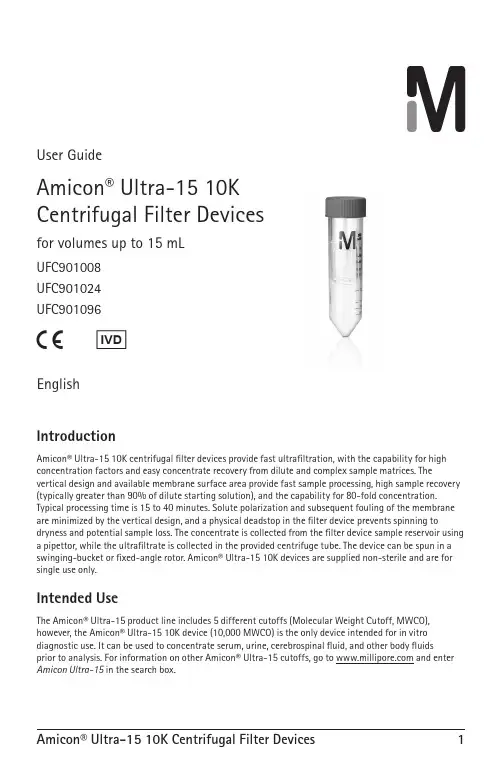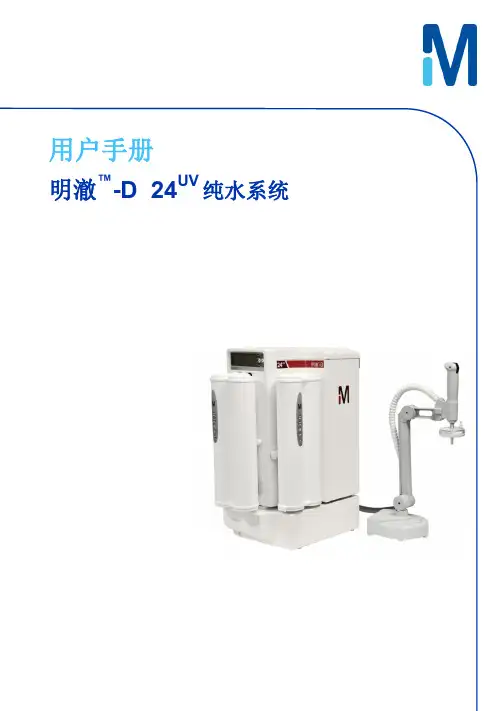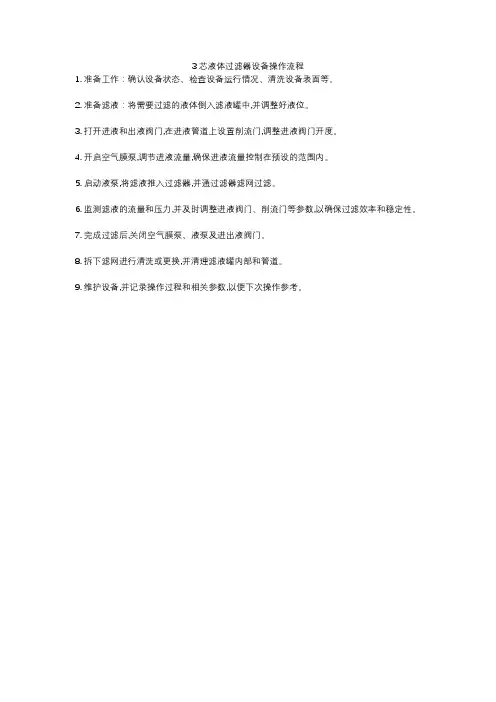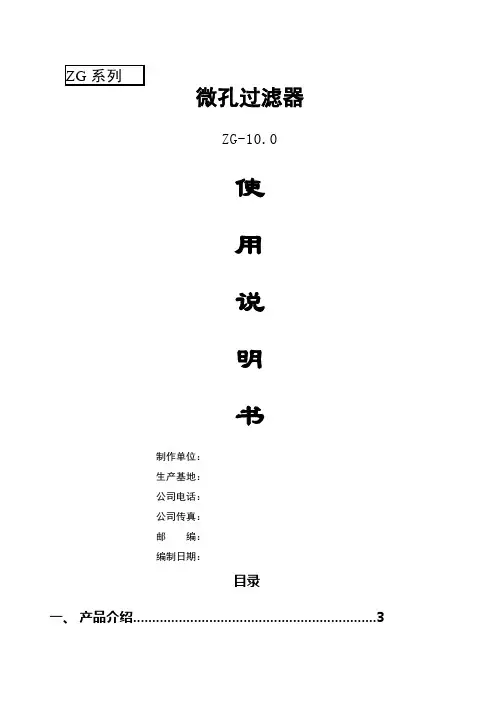MILLIPORE三联过滤器操作说明
milipure超滤管说明书

EnglishIntroductionAmicon® Ultra-15 10K centrifugal filter devices provide fast ultrafiltration, with the capability for high concentration factors and easy concentrate recovery from dilute and complex sample matrices. Thevertical design and available membrane surface area provide fast sample processing, high sample recovery (typically greater than 90% of dilute starting solution), and the capability for 80-fold concentration. Typical processing time is 15 to 40 minutes. Solute polarization and subsequent fouling of the membrane are minimized by the vertical design, and a physical deadstop in the filter device prevents spinning todryness and potential sample loss. The concentrate is collected from the filter device sample reservoir using a pipettor, while the ultrafiltrate is collected in the provided centrifuge tube. The device can be spun in a swinging-bucket or fixed-angle rotor. Amicon® Ultra-15 10K devices are supplied non-sterile and are for single use only.Intended UseThe Amicon® Ultra-15 product line includes 5 different cutoffs (Molecular Weight Cutoff, MWCO), however, the Amicon® Ultra-15 10K device (10,000 MWCO) is the only device intended for in vitro diagnostic use. It can be used to concentrate serum, urine, cerebrospinal fluid, and other body fluids prior to analysis. For information on other Amicon® Ultra-15 cutoffs, go to and enter Amicon Ultra-15in the search box.User GuideAmicon ® Ultra-15 10K Centrifugal Filter Devicesfor volumes up to 15 mLUFC901008UFC901024UFC901096CVApplications●Concentration of biological samples containing antigens, antibodies, enzymes, nucleic acids(DNA/RNA samples, either single- or double-stranded), microorganisms, column eluates, andpurified samples●Purification of macromolecular components found in tissue culture extracts and cell lysates, removalof primer, linkers, or molecular labels from a reaction mix, and protein removal prior to HPLC●Desalting, buffer exchange, or diafiltrationMaterials SuppliedThe Amicon® Ultra-15 10K device is supplied with a cap, a filter device, and a centrifuge tube.Required Equipment●Centrifuge with swinging-bucket or fixed-angle rotor with wells/carriers that can accommodate50 mL tubesCAUTION: To avoid damage to the device during centrifugation, check clearance before spinning.●Pipettor with 200 microliter (μL) tip for concentrate recoverySuitabilityPreliminary recovery and retention studies are suggested to ensure suitability for intended use. See the “How to Quantify Recoveries” section.Shelf LifeShelf life is 3 years from date of manufacture. Refer to expiration date on package label.Rinsing Before UseThe ultrafiltration membranes in Amicon® Ultra-15 10K devices contain trace amounts of glycerine. If this material interferes with analysis, rinse the device with buffer or Milli-Q® water before use. If interference continues, rinse with 0.1 N NaOH followed by a second spin of buffer or Milli-Q® water. CAUTION: Do not allow the membrane in Amicon® Ultra filter devices to dry out once wet. If you are not using the device immediately after rinsing, leave fluid on the membrane until the device is used. How to Use Amicon® Ultra-15 Centrifugal Filter Devices1. Add up to 15 mL of sample (12 mL if using a fixed-angle rotor) to the Amicon® Ultra filter device.2. Place capped filter device into centrifuge rotor; counterbalance with a similar device.3. When using a swinging-bucket rotor, s pin the device at 4,000 × g maximum for approximately15–40 minutes.When using a fixed-angle rotor, orient the device with the membrane panel facing up and spin at 5,000 × g maximum for approximately 15–40 minutes.NOTE: Refer to Figure 1 and Table 1 for typical spin times.4. To recover the concentrated solute, insert a pipettor into the bottom of the filter device and withdrawthe sample using a side-to-side sweeping motion to ensure total recovery. The ultrafiltrate can be stored in the centrifuge tube.NOTE: For optimal recovery, remove concentrated sample immediately after centrifugation. Desalting or DiafiltrationDesalting, buffer exchange, or diafiltration are important methods for removing salts or solvents in solutions containing biomolecules. The removal of salts or the exchange of buffers can be accomplished in the Amicon® Ultra-15 device by concentrating the sample, then reconstituting the concentrate to the original sample volume with any d esired solvent. The process of “washing out” can be repeated until the concentration of the contaminating microsolute has been sufficiently reduced. See example below.1 mg/mL100 mMNaCl200 μL of75 mg/mLprotein inNaCl200 μL of75 mg/mLprotein inNaClAdd 14.8 mL of10 mM NaClor exchangebufferPerformanceFlow RateFactors affecting flow rate include sample concentration, starting vol u me, chemical nature of solute, relative centrifugal force, centrifuge rotor angle, membrane type, and temperature. Figure 1 and Table 1 can be used to estimate the time required to achieve a given volume of filtrate or concentrate. A typical spin time for a 15 mL sample is approximately 15 to 40 minutes. While most of the sample is filtered in the first 15 to 30 minutes of centrifugation, the lowest concentrate volume (100–150 μL) is reached after spinning for 15 to 40 minutes.Spin conditions: Swinging-bucket rotor (4,000 × g, 15 mL starting volume),or fixed-angle rotor, (5,000 × g, 12 mL starting volume), room temperature.Protein marker used: Cytochrome c, n=6.Table 1. Typical Concentrate Volume vs. Spin TimeSpin conditions: Room temperature.Protein marker used: Cytochrome c, n=6 (mean value of 3 membrane lots).Shaded volumes were used for the calculation of protein recovery in Table 3.Protein Retention and Concentrate RecoveryThe membranes used in Amicon® Ultra devices are characterized by a molecular weight cutoff (MWCO); that is, their ability to retain molecules above a specified molecular weight. Solutes with molecular weights close to the MWCO may be only partially retained. Membrane retention depends on the solute’s molecular size and shape. For most applications, molecular weight is a convenient parameter to use in assessing retention characteristics. For best results, use a membrane with a MWCO at least two times smaller than the molecular weight of the protein solute that one intends to concentrate. Refer to Table 2.Table 2. Typical Retention of Protein MarkersMarker/Concentration MolecularWeightDeviceMWCO% RetentionSwinging-bucket% RetentionFixed-angleSpin Time(min)α-Chymotrypsinogen (1 mg/mL)25,00010K> 95> 9530 Cytochrome c (0.25 mg/mL)12,400> 95> 9530 Vitamin B-12 (0.2 mg/mL)1,350< 5< 530 Spin Conditions: Swinging-bucket rotor (4,000 × g, 15 mL starting volume), or fixed-angle rotor, (5,000 × g,12 mL starting volume), room temperature, n=6 (mean value of 3 membrane lots).Factors that determine sample recovery include the nature of the protein solute relative to the device MWCO chosen, starting concentration, and concentration factor. Table 3 provides typical recoveries for Amicon® Ultra-15 10K device.Table 3. Typical Concentrate RecoveryConcentrate Concentration ConcentrateSpin Conditions: Swinging-bucket rotor (4,000 × g, 15 mL starting volume), or fixed-angle rotor, (5,000 × g,12 mL starting volume), room temperature, n=6 (mean value of 3 membrane lots). The shaded volumes were taken from Table 1.Maximizing Sample RecoveryLow sample recovery in the concentrate may be due to adsorptive losses, over-concentration, or passage of sample through the membrane.●Adsorptive losses depend upon solute concentration, its hydrophobic nature, temperature and timeof contact with filter device surfaces, sample composition, and pH. To minimize losses, removeconcentrated samples immediately after centrifugal spin.●If the starting sample concentration is high, monitor the centrifugation process in order to avoid over-concentration of the sample. Over-concentration can lead to precipitation and potential sample loss.●If the sample appears to be passing through the membrane, choose a lower MWCO Amicon® Ultra-15device.How to Quantify RecoveriesCalculate total recovery, percent concentrate recovery, and percent filtrate recovery using the method below. The procedure provides a close approximation of recoveries for solutions having concentrations up to roughly 20 mg/mL.NOTE: Appropriate assay techniques include absorption spectrophotometry, radioimmunoassay, refractive index, and conductivity.Direct Weighing ProcedureThe density of most dilute proteins is nearly equal to the density of water (i.e., 1 g/mL). Using this property, the concentrate and filtrate volumes can be quantified by weighing them and converting the units from grams to milliliters. This technique is valid only for solutions with concentrations of approximately20 mg/mL or less.1. Before use, separately weigh the empty filter device, the centrifuge tube, and an empty tube forconcentrate collection.2. Fill filter device with solution and reweigh.3. Assemble device and centrifuge per instructions.4. Collect the concentrate with a pipettor and dispense it into the preweighed concentrate collection tube.5. Remove the device from the centrifuge tube and weigh the centrifuge tube and concentrate collectiontube.6. Subtract weight of empty device/tubes to calculate weights of starting material, filtrate, andconcentrate.7. Assay the starting material, filtrate, and concentrate to determine solute concentration.8. Calculate recoveries using the weight/volume data and the measured concentrations as follows:% concentrate recovery = 100 × W c × C c W o × C o% filtrate recovery = 100 × W f × C f W o × C o% total recovery = % concentrate recovery + % filtrate recoveryW c = total weight of concentrate before assayW o = weight of original starting materialW f= weight of filtrateC c= concentrate concentrationC o= original starting material concentrationC f= filtrate concentrationSpecificationsMaximum initial sample volumeSwinging-bucket15.0 mLFixed-angle rotor12.0 mLTypical final concentrate volume 150–300 μLMaximum relative centrifugal forceSwinging-bucket rotor4,000 × gFixed-angle rotor5,000 × gActive membrane area7.6 cm2DimensionsFilter device in tube (capped)Length: 119 mm (4.7 in.)Diameter: 33.5 mm (1.3 in.) Filter deviceLength: 72.0 mm (2.8 in.)Diameter: 29.7 mm (1.2 in.) Materials of ConstructionFilter device Copolymer styrene/butadieneMembrane Ultracel® low binding regenerated cellulose Filtrate tube PolypropyleneFiltrate cap and liner PolyethyleneChemical CompatibilityAmicon® Ultra centrifugal devices are intended for use with biological fluids and aqueous solutions. Before use, check the sample for chemical compatibility with the device.Table 4. Chemical Compatibility of Amicon® Ultra Filter DevicesAcids Concentration Concentration Acetic acid ≤ 50%*Phosphoric acid ≤ 30% Formic acid ≤ 5%*Sulfamic acid≤ 3% Hydrochloric acid ≤ 1.0 M Sulfuric acid ≤ 3% Lactic acid ≤ 50%Trichloroacetic acid (TCA)≤ 10%* Nitric acid ≤ 10%Trifluoroacetic acid (TFA)≤ 30%* AlkalisAmmonium hydroxide ≤ 10%Sodium hydroxide ≤ 0.5 M Alcoholsn-Butanol ≤ 70%Isopropanol ≤ 70% Ethanol ≤ 70%Methanol ≤ 60% DetergentsAlconox® detergent ≤ 1%Sodium dodecyl sulfate (SDS)≤ 0.1% CHAPS detergent≤ 0.1%Tergazyme®detergent ≤ 1% Lubrol® PX detergent≤ 0.1%Triton® X-100 surfactant≤ 0.1% Nonidet™ P-40 surfactant≤ 2%Tween® 20 surfactant≤ 0.1% Sodium deoxycholate≤ 5%Organic solventsAcetone not recommended Ethyl acetate not recommended Acetonitrile ≤ 20%Formaldehyde ≤ 5% Benzene not recommended Pyridine not recommended Carbon tetrachloride not recommended Tetrahydrofuran not recommended Chloroform not recommended Toluene not recommended Dimethyl sulfoxide (DMSO)≤ 5%*MiscellaneousAmmonium sulfate Saturated Phenol≤ 1% Diethyl pyrocarbonate ≤ 0.2%Phosphate buffer (pH 8.2)≤ 1 M Dithiothreitol (DTT)≤ 0.1 M Polyethylene glycol≤ 10% Glycerine≤ 70%Sodium carbonate ≤ 20% Guanidine HCl ≤ 6 M Tris buffer (pH 8.2)≤ 1 M Imidazole≤ 100 mM Urea ≤ 8 M Mercaptoethanol≤ 0.1 M* Contact with this chemical may cause materials to leach out of the component parts. Solvent blanks are recommended to determine whether leachables represent potential assay interferences.Product Labeling SymbolsThe following table defines the symbols found on Amicon® Ultra-15 10K device labels.Product Ordering InformationThis section lists the catalogue numbers for Amicon® Ultra Ultrafiltration Devices. See the Technical Assistance section for contact information. You can purchase these products on-line at/products.* Amicon® Ultra-4 and -15 10K devices are for in vitrodiagnostic use. All other devices are for research use only.NoticeThe information in this document is subject to change without notice and should not be construed as a commitment by Merck Millipore Ltd. (“Millipore”) or an affiliate. Neither Merck Millipore Ltd. nor any of its affiliates assumes responsibility for any errors that may appear in this document.Technical AssistanceFor more information, contact the office nearest you. Up-to-date world-wide contact information is available on our web site at /offices. You can also visit the tech service page on our web site at /techservice.Standard WarrantyThe applicable warranty for the products listed in this publication may be found at/terms (“Conditions of Sale”).M Merck Millipore Ltd.Tullagreen,Carrigtwohill,Co. Cork, IrelandMade in IrelandThe M logo, Millipore, Amicon, Milli-Q, and Ultracel are registered trademarks of Merck KGaA, Darmstadt, Germany.All trademarks of third parties are the property of their respective owners.© 2014 EMD Millipore Corporation. Billerica, MA, U.S.A. All rights reserved.PR04318TR, Rev. B, English, 10/14。
merck millipore 默克密理博纯水超纯水一体系统明澈D24UV操作手册

11
明澈-D 24 UV
需要的物品
13
物品检查清单 安装开始前请核实所有物品是否可用。
o 纯水系统主机 (A) o 用户手册和快速参考指南 (B) o 外部电源 (C) o PROGARD®预处理柱和 Q-GARD®超纯水柱(D) o 储水水箱:30、60 或 100 升(E) o POU 取水器(F) o 包含下述的附件包: 管材 配件 电源
8
2 显示器和小键盘
9
3 Progard® 预处理柱位置
10
4 锁定手柄
11ห้องสมุดไป่ตู้
5 消毒/清洁口
12
6 电源接口
13
7 系统进出水口连接
14
*系统断电时,应将电源与插座断开。
说明 系统 ID 和序列号 电源适配器* Q-GARD®超纯水柱位置 超纯水进出口接口 POU(用水点)取水POU 取水开关取水器终端过滤器
重要提示!
应在干净且干燥的地方安装并操作您的纯水系统。请参考本手册最 后部分的环境要求。
您的纯水系统不适于家庭使用。
纯水系统长时间断电会使计时器的电池放电,导致失去时间和日期记录。如果长 时间关闭纯水系统,应使用实验室关闭模式请与您的服务代表联系。
经常保存系统的历史记录-每三个月或每半年。参见 Millitrack 文档。
软件选项millitrack软件是通过ajax异步javascript和xml技术开发的一种嵌入式gui图形用户界面软件它能运用tcpip以太网协议通过点到点计算机或直接通过网络连接生成交互式网页
用户手册
明澈™-D 24UV 纯水系统
序言
感谢您购买我们的纯水系统。 对于任何疑问或请求,请根据以下联系信息与 Merck Millipore 联系。
3芯液体过滤器设备操作流程

3芯液体过滤器设备操作流程
1. 准备工作:确认设备状态、检查设备运行情况、清洗设备表面等。
2. 准备滤液:将需要过滤的液体倒入滤液罐中,并调整好液位。
3. 打开进液和出液阀门,在进液管道上设置削流门,调整进液阀门开度。
4. 开启空气膜泵,调节进液流量,确保进液流量控制在预设的范围内。
5. 启动液泵,将滤液推入过滤器,并通过滤器滤网过滤。
6. 监测滤液的流量和压力,并及时调整进液阀门、削流门等参数,以确保过滤效率和稳定性。
7. 完成过滤后,关闭空气膜泵、液泵及进出液阀门。
8. 拆下滤网进行清洗或更换,并清理滤液罐内部和管道。
9. 维护设备,并记录操作过程和相关参数,以便下次操作参考。
Milli-Q纯水机标准操作规程

一目的规范Milli-Q 型超纯水机的标准操作。
二 适用范围Milli-Q 型超纯水机的使用。
三 职责1. 实验人员负责仪器的日常使用。
2. 仪器管理人员负责仪器的维护保养。
四 工作程序 1. 仪器组成1.1 主体结构:分为主机和取水器两部分。
1.2 过滤柱:左侧为Q-Gard 纯化柱,用于初级纯化;右侧为Quantum 纯化柱,用于精制纯化。
二者位于主机内。
1.3 Millipak 过滤器,用于终极纯化,连接于取水器上。
2. 仪器使用 2.1开机2.1.1 开机前,请确认电源与本机要求输入电源相符,插座必须接地线,检查水源是否充足畅通。
2.1.2 电源开启后,纯水机自动开机。
2.1.3 保证电源和水源充足连通;停用时间超过一个月时,切断电源即可。
2.2 取水2.2.1 取水前观察液晶面板,如状态均显示为“--”或者各项指标不合格时,按取水器控制面板上 实现强制循环。
2.2.2 定量取水。
观察取水器显示屏上方所显示取水体积,按取水器面板上按键调整至合适的取水量,按取水器面板上即 可从取水器定量取水。
2.2.3 非定量取水。
低流速取水。
按住取水器上蓝色取水开关至L 位,水以低流速流出,停止取水时放手即可。
中流速取水。
按住取水器上蓝色取水开关至M 位,水以中流速流出, 停止取水时放手即可。
高流速取水。
按下取水器上蓝色取水开关至H 位,放手则开关锁定,水2.3显示屏各指标信息2.3.1 ①仪器状态。
READY 为就绪,STANDBY 为待机。
2.3.2 ②全部显示为蓝色时即为正常状态,当不能出水时⑥将显示为红色。
2.3.3 ③各参数如下:2.3.4 ④说明闪烁时Q-Gard 纯化柱需要更换 Q-Gard 纯化柱 缺失 Q-Gard 纯化柱 未使用 Q-Gard 纯化柱 使用中操作标准文件编码:SOP-FX-2013-015 版本号:02题目:Milli-Q 纯水机标准操作规程参数 数值 单位 电阻率 18.2 M Ω.cm@25℃ TOC ≤5 ppb(μg/l) 温度 ℃ 取水体积L日常 L M H体积指示。
过滤器使用说明书

微孔过滤器ZG-10.0使用说明书制作单位:生产基地:公司电话:公司传真:邮 编:编制日期:目录一、 产品介绍 (3)二、产品特点 (3)三、滤芯的选择 (3)四、设备技术参数 (4)五、使用说明 (4)六、操作注意事项 (6)七、设备的维护与保养 (6)八、售后服务承诺 (7)九、合格证 (7)十、随机附件表 (8)一、产品介绍:本设备可用于食品、乳品、饮料、酒类、中药、化工行业的液体物料的气体的过滤。
采用折叠式滤芯,折叠式滤芯是一种先进的固定型深层过滤芯,过滤公称精度范围可以从0.1μm直600.1μm。
滤膜不受进料压力波动而影响过滤精度。
其特有的低压差,高通量、良好的过滤精度能较低的经济费用成为取代线绕式、棉饼和纸板等非固定型过滤芯的新型滤芯而深受用户欢迎。
二、产品特点:①化学相容性广、流通量大、压差低、使用寿命长。
②过滤精度范围广、选择度大、可满足各种应用场合。
③采用热熔工艺,牢固且无释放物污染产品。
三、滤芯的选择:1、滤芯的用途很广泛,滤芯的品种、规格较多,选择型号是很重要的。
根据用途可分为过滤液体和气体二种,规格大小可以分为5〃、10〃、20〃、30〃和40〃等。
工作压力一般在0.1Mpa—0.4 Mpa。
由于滤芯孔径不同,其流量也不尽相同,如0.2um—0.4 um过滤沌水的标准在300—500kg/h,如果要提高每小时的过滤量,则可以用多芯或20〃、30〃、40〃英寸组合,例如要过滤5t/h的无菌水,则可以选用0.2 um,30英寸7芯的过滤器。
若过滤杂质多且有粘度,则应添加前置预过滤设备。
气体的过滤与液体过滤稍有不同,它的过滤量以每分钟立方气体来计算。
10英寸滤芯,孔径φ0.22 um,压力在0.12 Mpa,压差在0.01 Mpa时,流量为4-6m3/min,在发酵工业上广泛应用。
2 、合适的滤芯,选用适当的孔径,若要除菌则选用0.2um-0.5um孔径的滤芯、药用针剂、抗菌素、血制品等用聚砜滤芯。
Milli-Q超纯水机使用、清洁及维护操作规程

Milli-Q超纯水机使用、清洁及维护操作规程1目的规范质量控制中心试剂、试药的管理,明确对其的管理和使用。
2范围本规程适用于质量控制中心所用试剂、试药的接收、储存及发放。
3职责3.1质量控制中心检验人员应根据本文件的要求执行。
3.2质量控制中心检验人员对本文件的实施负责。
4内容4.1使用4.1.1模式4.1.1.1待机模式在准备维护Milli-Q系统之前,选择待机模式。
处于待机模式时,不能取水。
处于待机模式时,按下Q-POD取水器开关,使Milli-Q系统减压。
见下图所示。
4.1.1.2就绪模式处于就绪模式时,能从Q-POD取水器中取水。
在大部分时间里,Milli-Q系统都应该处于就绪模式。
无论是在夜间、周末,或是其它未被使用的时间段里,都应该让Milli-Q系统处于就绪模式。
在待机模式下,主显示器和Q-POD取水器显示都如图所示。
4.1.1.3从待机模式切换到就绪模式选择就绪,按下键4.1.1.4 从就绪模式切换到待机模式选择待机,按下键4.1.2 了解Q-POD 取水器显示器和键盘 4.1.2.1 Q-POD 取水器显示器闪烁4.1.2.2Q-POD取水器键盘减少取水量增加取水量开始纯水循环定量取水打印产水水质4.1.3查看操作4.1.4 手动取水4.1.4.1 调整Q-POD 取水器的高度按下此处并保持住,上下移动Q-POD 取水器。
4.1.4.2 使用Q-POD 取水器为了取水,在就绪模式下,按下Q-POD 取水器开关。
O L M HQ-POD取水器内置一个微型开关。
如果您把Q-POD取水器开关按到底后松开,Q-POD 微型开关就处于锁定位置。
当微型开关处于锁定位置时,纯水就会以高流速从Q-POD取水器中持续流出。
再次把Q-POD取水器开关按到底后松开,就能使微型开关解锁。
4.1.5定量取水使用Q-POD取水器能实现定量取水,其定量为0.1L,0.25 L,0.5 L,0.75 L,1 L,1.25 L,1.5 L,1.75 L,2L,3 L,……,60L。
Millipore超纯水制造系统操作及保养手册
範例: 針對共同項目
M ILLI-Q Ac. Gr. Bio.Syn.A10
: 所有線條皆為柱狀。 (表示本功能是用在所有四種機型)
針對特殊系統: Gradient 所有圖形皆收錄在手冊最後之摺頁內。
系統各部分圖形 - 詳列於手冊之後
如何使用本手冊
本手冊是說明如何安裝耗材,使用及保養您的Milli-Q純水系統,雖然Milli-Q系統非常容易使用,但還 是強烈建議使用者徹底閱讀本手冊,可防止系統故障,可使使用者更熟悉所有功能及操作指令。
如何區分不同 Milli-Q 機型所涵蓋之不同應用內容
本操作手冊使用下述表記來區分。
如何使用本手冊 ......................................................................................................................................... 4 如何區分不同機型所針對的應用內容...................................................................................................... 4 警告標誌之意義.......................................................................................................................................... 4 前言 ............................................................................................................................................................. 5 一般說明...................................................................................................................................................... 5 系統運作原理.............................................................................................................................................. 5 系統結構流程圖.......................................................................................................................................... 6 規範.............................................................................................................................................................. 7 裝置 ............................................................................................................................................................. 9 系統裝置...................................................................................................................................................... 9 裝置方法.................................................................................................................................................... 10 MILLI-Q 系統操作 .................................................................................................................................. 13 操作的幾種模式........................................................................................................................................ 13 標準顯示.................................................................................................................................................... 13 附加顯示.................................................................................................................................................... 14 按鍵使用方法............................................................................................................................................ 15 MILLI-Q 系統啟動 ..................................................................................................................................... 20 保養 ........................................................................................................................................................... 21 例行保養時間表........................................................................................................................................ 21 例行保養.................................................................................................................................................... 22 疑難排除 ................................................................................................................................................... 25 疑難排除、訊息........................................................................................................................................ 25 警告號碼表................................................................................................................................................ 27
MILLIFLEX PLUS 说明书
-3-
密理博中国有限公司
产品使用说明书
4.2.4. 排液管的安装………………………………………………………………………………9 4.2.5. 泵头的安装…………………………………………………………………………………9 4.3. 参数设置,校验与检验…………………………………………………………………………….10 4.3.1. 初始启动…………………………………………………………………………………..11 4.3.2. 参数设定…………………………………………………………………………………..12 4.3.3. 对称量功能的效验……………………………………………………………………… 13 4.3.4. 对泵的功能的检验………………………………………………………………………..14
过滤机操作步骤
过滤机操作步骤
第一步:打开进料阀,溢流阀,然后启动泵,开始进料使物料充满整个过滤机,
在视镜中看到有物料流出为止。
第二步:打开循环阀,关闭溢流阀,开始预涂,在视镜中看到物料有浑浊慢慢变清,大约时间5—10分钟。
第三步:物料变清以后,打开清液阀,关闭循环阀,开始过滤,(最好两者同时操作,压力不能有太大的波动,否则会出现过滤不清的现象)。
第四步:物料过滤结束后,停止泵关闭关闭进料阀,同时马上开启压缩空气阀,
打开余料压出阀,关闭清液阀,开始压余料,(注:压力一般控制在2公斤左右,如压力过大,打开循环阀三分之一)。
直到视镜中看到跑空气为止,说明余料压完。
第五步:余料压完后,关闭余料压出阀,进行吹干,那时只有压缩空气阀和循
环阀三分之一打开,其他阀门均关闭状态,吹干压力也控制在2公斤左右,大约时间25-40分钟。
第六步:吹干结束后,关闭压缩空气阀,循环阀,打开溢流阀,放空压力,在压力表上看到零为止。
第七步:压力放空后,打开碟阀上的压缩空气阀门,启动碟阀开,然后开始振动。
注:过滤机压力不得超过4公斤。
在有物料有压力的情况下不得打开过滤机。
在进物料前应把二联件上的压力放空,防止工作人员误操作。
MILLIPORE三联过滤器操作说明
Microfil过滤系统安装指南一:过滤系统简介Millipore公司的全自动过滤系统Microfil 过滤系统主要是针对液体样品进行微生物检验用的专门自动系统,具有操作简便,使用成本低,耗材灭菌简单,可以高温高压灭菌。
最适合科研单位进行科学研究和样品检验,以下是这套系统的具体参数。
二:Microfil 过滤系统的用途※ 环境中水的致病微生物富集与检验※ 食品饮料的微生物限度检验※宾馆空调水的军团菌的微生物检验※ 饮用水和水系统的致病微生物检验与分离三:产品安装过程1.按照合同清点物品安装Microfil过滤系统的必须的配件主要有:三连式过滤支架,抽滤瓶(2个),硅胶塞(1包),真空压力两用泵,硅胶管(1-2根),漏斗(MIHAWG072),膜片(多包)。
首先将几个配件取出,将三联支架放置在平稳的操作台上,有螺纹头的一方朝右手边,这时检查Microfil过滤支架的白色盖子和不锈钢垫片是否完好,然后拿出管子,不带硬塞的一头接到Microfil过滤支架螺纹头,然后将另外一头接到蓝色硅胶塞上,必要的时候需要加上一点润滑剂(液体石蜡等),将第二根管子接到第一个抽滤瓶的头颈出的出口处,同样的将第二根管子的带塞端插到第二个抽滤瓶的硅胶塞上,从泵体过来的的管子连在第二个抽滤瓶的头颈处,第一步完成。
2.将整孔泵所配的硅胶管从中间剪开,把白色呼吸器两头接到管子上,一头接到真空压力两用泵的真空端,另一头接在第二个抽滤瓶的脖颈处。
这样一套过滤装置就装好了。
注意事项:四:Microfil过滤系统的维护:1.系统应该定期的高温高压灭菌,一月一次2.系统应该定期使用消毒剂灭菌,一周一次,3.系统在每次使用后进行清洗,使用纯水清洗。
4.系统不表面使用酒精喷撒即可。
五:Microfil过滤系统的使用方法注意:以下所有的操作都要遵循无菌操作规范1.在无菌的培养皿或无菌Petri-Pad中加入足量的培养基。
2.用火焰在Microfil的支撑表面灭菌3-5秒钟,特别要注意支撑表面的边缘部分。
- 1、下载文档前请自行甄别文档内容的完整性,平台不提供额外的编辑、内容补充、找答案等附加服务。
- 2、"仅部分预览"的文档,不可在线预览部分如存在完整性等问题,可反馈申请退款(可完整预览的文档不适用该条件!)。
- 3、如文档侵犯您的权益,请联系客服反馈,我们会尽快为您处理(人工客服工作时间:9:00-18:30)。
Microfil过滤系统安装指南
一:过滤系统简介
Millipore公司的全自动过滤系统Microfil 过滤系统主要是针对液体样品进行微生物检验用的专门自动系统,具有操作简便,使用成本低,耗材灭菌简单,可以高温高压灭菌。
最适合科研单位进行科学研究和样品检验,以下是这套系统的具体参数。
二:Microfil 过滤系统的用途
※ 环境中水的致病微生物富集与检验
※ 食品饮料的微生物限度检验
※宾馆空调水的军团菌的微生物检验
※ 饮用水和水系统的致病微生物检验与分离
三:产品安装过程
1.按照合同清点物品
安装Microfil过滤系统的必须的配件主要有:三连式过滤支架,抽滤瓶(2个),硅胶塞(1包),真空压力两用泵,硅胶管(1-2根),漏斗(MIHAWG072),膜片(多包)。
首先将几个配件取出,将三联支架放置在平稳的操作台上,有螺纹头的一方朝右手边,这时检查Microfil过滤支架的白色盖子和不锈钢垫片是否完好,然后拿出管子,不带硬塞的一头接到Microfil过滤支架螺纹头,然后将另外一头接到蓝色硅胶塞上,必要的时候需要加上一点润滑剂(液体石蜡等),将第二根管子接到第一个抽滤瓶的头颈出的出口处,同样的将第二根管子的带塞端插到第二个抽滤瓶的硅胶塞上,从泵体过来的的管子连在第二个抽滤瓶的头颈处,第一步完成。
2.将整孔泵所配的硅胶管从中间剪开,把白色呼吸器两头接到管子上,一头接到真空压力两用泵的真空端,另一头接在第二个抽滤瓶的脖颈处。
这样一套过滤装置就装好了。
注意事项:
四:Microfil过滤系统的维护:
1.系统应该定期的高温高压灭菌,一月一次
2.系统应该定期使用消毒剂灭菌,一周一次,
3.系统在每次使用后进行清洗,使用纯水清洗。
4.系统不表面使用酒精喷撒即可。
五:Microfil过滤系统的使用方法
注意:以下所有的操作都要遵循无菌操作规范
1.在无菌的培养皿或无菌Petri-Pad中加入足量的培养基。
2.用火焰在Microfil的支撑表面灭菌3-5秒钟,特别要注意支撑表面的边缘部分。
3.a ) 从易拉口端撕开S-Pak膜的外包装。
b)或者使用EZ-Pak分膜器打开包装并分出一张无菌膜。
4.镊子在火焰上灭菌并冷却,夹住膜并网格朝上的把它放置在不锈钢支撑的中央。
5.打开漏斗的底部包装(V型封口)。
从包装的最底端取出一个漏斗。
抓住漏斗的中部并小心的安装到底座上。
从漏斗的上边缘按下漏斗使之牢靠的卡在底座上。
注意:如果使用漏斗分配器,请参阅“使用漏斗分配器”部分。
6.漏斗包装袋重新封好以防止空气中的微生物污染。
(可以使用夹子把封口夹住)
7.把样品倒入漏斗中,根据漏斗上的刻度定量。
8.打开真空来过滤样品直到所有的样品完全穿过膜。
注意:膜和漏斗如果有必要淋洗的话可以在这个步骤之后进行。
Microfil漏斗为无残留设计一般不需要冲洗。
9.关闭到真空的阀门。
10.拿住漏斗边缘下方部分并慢慢的向后倾斜把它从底座上取下。
接下来手向下移动并用手掌侧面按下拨动杆,释放真空的同时也顶起了过滤膜。
11.使用用火焰灭过菌的镊子把膜取下。
12.把滤膜转移至装好固体培养基的培养皿或液体培养基的Petri-Pad平皿。
13.如果没有更多的同种样品需要检测那么可以处理掉用过的漏斗。
如果还有样品需要检测则按照步骤3,4更换一张过滤膜,接下来更换漏斗并把漏斗压紧在底座上。
重复7-13部分的操作。
14.把培养皿放入培养箱,注意有膜的一面朝下。
